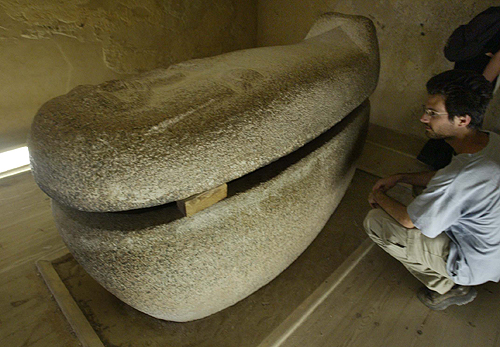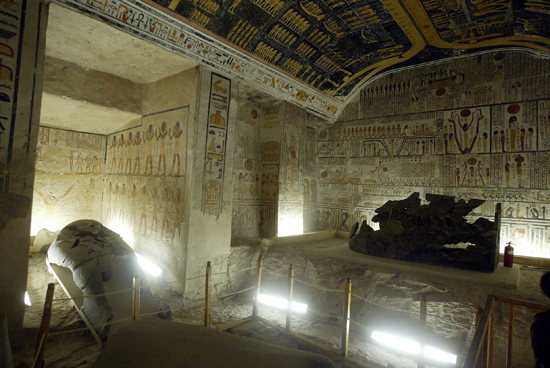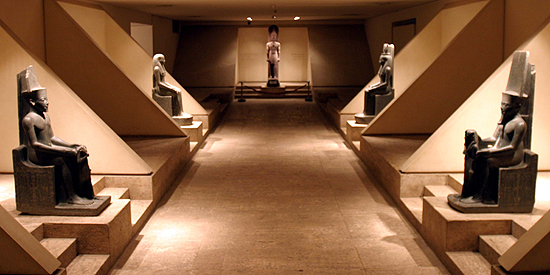Press Release - Dr. Zahi Hawass
March 2004
News from Thebes
Minister of Culture Farouk Hosni and Secretary general of
the Supreme Council of Antiquities (SCA) Dr. Zahi Hawass, along with top
American, German and Egyptian officials, paid a visit to Luxor on Sunday,
March 20, 2004. Their itinerary included the Theban necropolis, where the
tomb of Ramses VI was reopened after the recent restoration of its inner
sarcophagus; the mortuary temple of Seti I at Qurna; the colossi of Memnon
at Kom el-Hittan, where the German archaeological mission has just
stumbled upon a unique statue of a hippopotamus; and the new extension at
the Luxor Museum, where an exhibit of 140 objects illustrating the history
of Egypt's army during the New Kingdom (1569-1081 BC) will open in April.
The head of the Supreme Council of Luxor, Major General El-Dessuqi El-Banna;
ambassadors of both the United States and Germany in Cairo; and a number
of foreign and Egyptian Egyptologists were among the traveling delegation.
The Conservation of the Sarcophagus of Ramsses VI in the
Valley of the Kings
 |
King Ramsses VI was the fifth king of
the 20th dynasty (1156-1145 BC.). He came to the throne after the
death of his predecessor, Ramsses V, who had ruled Egypt for only one
year.
Ramsses VI ruled for six years and usurped the tomb of Ramesses V as
his own final resting place. He enlarged this rock-cut sepulcher into
one of the largest in the Valley of the Kings, with a series of halls
and descending corridors stretching in a straight line for about 100
meters, culminating in a burial chamber 45 meters deep. Its walls are
decorated with painted scenes and inscriptions from ancient religious
texts. The kingís mummy was buried inside two stone sarcophagi that
had been fitted one within other and placed within a pit cut in the
sunken floor of the burial chamber. The massive outer sarcophagus is
of red granite; the inner one is an anthropoid sarcophagus carved out
of a rare hard greenish stone. Both sarcophagi had been broken into
pieces centuries ago; the inner sarcophagus had been shattered into
hundreds of small pieces. |
Between June 2001 and 2003, a major conservation project
for the inner sarcophagus of Ramesses VI and its lid was carried out by
the American Research Center in Egypt (ARCE), in collaboration with the
SCA. This was funded by the United States Agency for International
Development and led by Egyptologist Edwin Brock.

All of the fragments of the inner sarcophagus have now been collected,
cleaned and re-assembled. Although many pieces are missing, enough has
been preserved for the stone box to be partly reconstructed up to its
original height, and to give a clear idea of its size and decoration. It
is carved with scenes designed to assure the perpetual rebirth of the king
through his identification with the sun god Re and with Osiris, and bears
traces of paint. It now rests on a large limestone base that has been
shaped to represent in size and outline the original red granite outer
sarcophagus. This newly restored sarcophagus gives the visitor the
opportunity to see the last surviving remains of the many splendid
artifacts that once accompanied the king into his afterlife.
The Mortuary Temple of Seti I in Qurna
The mortuary temple of Seti I lies in the northern portion
of the Theban necropolis, on the western side of the ancient village of
Qurna (Gurna). It was constructed by Seti I, second king of the 19th
Dynasty, and dedicated to his father, Ramesses I, and the god Amun-Re. It
once stood as the first station on the west bank along a processional
street of temples and tombs that led from the state temple of Amun at
Karnak on the east bank, across the river to this temple, and then south
to the temple of Deir el-Bahari.
Modern excavations have been carried out in this temple complex by the
German Archaeological Institute in Cairo, which began work in 1970. Since
this time, much of the complex has been cleared; the temple has been
photographically and photogrammetrically documented; the inscriptions have
been copied; and the reliefs have been analyzed. Some reconstruction was
also carried out, in cooperation with the Egyptian Antiquities
Organization. Devastating thunderstorms in 1994 did significant damage to
this restoration work, but the modern walls served to protect the ancient
ones to a certain extent. The restoration work was completed in the winter
1998-1999, under the supervision of Dr. Rainer Stadelmann and Dr. Gunter
Dreyer, respectively former and current directors of the German
Archaeological Institute in Cairo.
A Hippo from Kom El-Hittan
The European mission working on the Amenhotep III Temple
Conservation Project at Kom el-Hittan (the site of the Colossi of Memnon)
has stumbled upon the large headless statue of a hippopotamus made of
alabaster. This was uncovered in the northern portico of the Hypostyle
Court of Amenhotep IIIís temple, which was built sometime between c. 1410
and 1372 BC.
Hourig Sourouzian, head of the European mission, reports that the newly
discovered statue had been previously seen during excavations carried out
during the 1970ís, but that it had been recovered and no record of its
location had been made; neither had it been drawn or photographed. The
height of the statue is 130cm, its width is 73 cm and its length is 118cm.
This is the first time that such a large statue of a hippopotamus has been
found; previously discovered images are restricted to wall scenes and
small models. Four statues of the lioness goddess Sekhmet have been also
found in the area. All of the newly discovered statues will be the focus
of major restoration work.
This project is funded by the Association of the Colossi of Memnon; the
thirty-plus members of the working team hail from 12 different countries,
including Egypt, Germany, Austria, Armenia, Belgium, France, Japan,
Luxemburg, Poland, Russia, Spain, and the Czech Republic.
The Extension of Luxor Museum

The newly organized extension of Luxor museum, which will be opening in
late April, illustrates the history of the ancient Egyptian military, with
a special focus on the army of the New Kingdom (c. 1539-1075). The 140
artifacts on display include weapons such as swords, knifes, war chariots,
shields, and arrows; stone balls and instruments used to sharpen arms; and
statues of well-known warriors kings such as Tuthmosis III, Seti I,
Ramesses II, and Ramses III.
The high point of the exhibit will be the mummies of two kings: Ahmose I,
first king of the 18th Dynasty; and Ramesses I, founder of the 19th
Dynasty. Ahmose I set the stage for the great empire of the New Kingdom by
defeating the Hyksos, foreign settlers who had ruled much of Egypt for a
century. His mummy was discovered in the late 19th century in a cache of
mummies at Deir el-Bahari. This cache had first been found by a local
family, the Abd el-Rassuls, who successfully hid their find for ten years.
The mummy of Ramesses was recently returned to Egypt after 130 years of
roaming around museums and archaeological laboratories in the United
States. It was bought by the Niagara Falls Museum in the 1870s, and is
thought to have been taken from the royal cache by the Abd el-Rassuls. It
was purchased recently by the Michael C. Carlos Museum in Atlanta, who
subjected it to a number of intensive, but non-invasive, tests. When the
likelihood that this mummy was in fact Ramesses I was determined to be
90%, the Michael C. Carlos offered to return it to Egypt.
|


